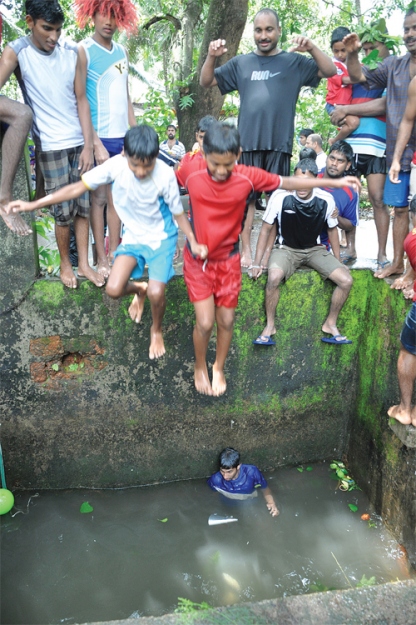24 Jun 2017 | 03:36am IST
Where are the wells for Sao Joao?
The feast of St John the Baptist has a unique flavour in Goa. Wells are decorated and the revellers adorned with a crown of fresh flowers, make it a point to take a grand leap into the wells. Over the years, the number of wells in use has dropped drastically as it is tedious to maintain them. Café looks at the new scheme by the Government, ‘Nital Goem Nital Baim’ and how the tradition of Sao Joao still continues in villages of Goa
Dolcy D’Cruz
Traditionally, the festival
of Sao Joao was celebrated with youngsters from a village getting together at a
village well. They would wear a
copel
made of
colourful leaves, fruits and flowers and visit several houses where they would
be offered fruits and local alcohol. After consuming the fruits and drinks, the
youngsters, especially boys would take a traditional dip (jump) in the closest
well.
To help maintain these wells throughout the year, the State Government
launched the scheme ‘
Nital Goem Nital Baim’ in a bid to provide
financial assistance up to Rs 50,000 to repair the existing wells that is only
private wells for public use. “The scheme is valid for owners of wells which
are registered with the department, and a total of Rs 50,000 will be provided
per well for the repairs which include the construction of a parapet,
plastering with glazed tile pieces, repairs of electrical equipment if
necessary and cleaning of said well, including de-watering,” says Chief
Engineer of WRD, S T Nadkarni. However, one will have to source the labour to
get the work done themselves, as the Government scheme only provides the
financial assistance.
Marius Fernandes of Salvador de Mundo has been solely relying on well
water and doesn’t have a Government water connection. “For the past 16 years,
we have been cleaning and maintaining the well on an annual basis. There are
skilled people in the villages itself who do it for us. Vinayak cleans our well
every year and he brings along another person as it is a two person’s job. They
use a ladder if the well is too deep. One person clears the well and cuts all
the plants and shrubs, while the second person clears the flow of the water,
letting the spring water flow. Those who build the wells are more aware of the
origins of the spring for the wells,” says Marius.
69 year old Thomas Fernandes from Pomburpa has seen the Sao Joao of his
childhood evolve into the trending swimming pool Sao Joao celebrations.
However, as a strict disciplinarian and a respected member of his village,
Thomas for 13 years, has been heading the ‘Sao Joao on a Whistle’ celebrations,
at Arao Ward in Pomburpa. The villagers will be jumping in ten wells in the
ward, with permission from the families, and each one will be monitored by
Thomas Fernandes, who will blow the whistle for youngsters to jump in the well
and get out of the well in a synchronised pattern. “The celebrations begin at
3pm and we meet at the First Cross near the St John the Baptist Well. We say a
few prayers and then sing
mandos
. I blow the
whistle and they are allowed to jump in the well and enjoy a swim. After around
ten minutes, I blow the whistle again and they all have to come out of the
well. Earlier, we had nine wells, and then the tenth one was built by the
government,” says Thomas. The celebrations end with prayers at the St Cajetan
Chapel before sunset.
Newly married couples serve an assortment of fresh fruits called ‘
dhali’,
but no alcohol is allowed at this celebration. Interestingly, nearly 50 per
cent of the village wells are still maintained and used for drinking water. The
villagers even request the participants to take a leap in their wells. “The
villagers clean their wells by May and even the Health Department in the
village gives them medicinal powder to keep their wells clean. Another
important aspect of the celebrations is the
Zagracho Khuris
or the Sao Joao Cross, where we say our prayers. The Cross is nearly 150
years old and
Zagor
used to be performed near it. My only hope is that the true tradition of
Sao Joao is continued by the youngsters of the village,” concludes
Thomas.

